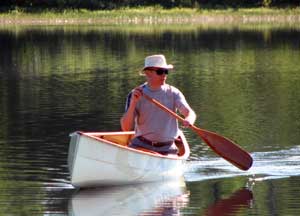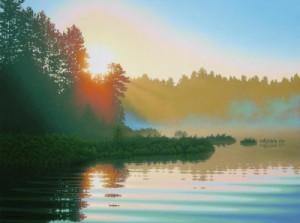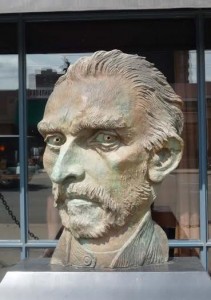Off-Season Artists: Joseph Pearce
Here’s the next instalment in our Off-Season Artists series, in which Alex, our go-to guy for all things internet, has chats with some of the Algonquin Art Centre’s creators. In this edition, we speak with Joseph Pearce, painter, paddler, and all-round lovely guy. So pour a cup of tea, pretend the steam is the mist rising off a lake as you sit in your canoe at sunrise, and enjoy!
Like a lot of the artists in the Canadian tradition of wilderness painters, canoeing seems to be a huge part on your life, and a key point of perspective in your art. Tell me about your background in canoeing. When did you get your start on the water? What was your favourite trip?
Besides my love of family, my love of canoeing is the biggest part of my life. Everything else (including my career) has followed from that. I got hooked on camping as a kid, but I didn’t really get into a canoe until my late twenties. Then in October of 1984 (a year before starting my art career), I rented a canoe on Lake Opeongo and did a five-day solo trip to the famous Hailstorm Creek Bog and back. That was interior trip #1. It proved to be a challenging, rain-soaked experience, but it still managed to cement my passion for the Algonquin interior. Thirty-one years and 103 interior canoe trips later, the millions of memories that I have generated have come to define my life from a personal perspective. Of course, the fact that I have been able to parlay all of those trips into an integral part of a full-time art career is incredibly rewarding—not to mention being very convenient. I can’t possibly point to any one trip as my favourite. But I have definitely benefited most from the many important people with whom I have shared my canoe over the years (my wife Helen, my brother John, and a great group of dear friends).
I feelvery fortunate to have been given the opportunity to do what I do… paddle, portage and camp throughout such a magical and mythical piece of Canadian wilderness, and then interpret it, in so many ways, onto canvas in my studio. I am certainly not the first Canadian to be artistically inspired by Algonquin Park, and I certainly won’t be the last. I’m just glad to be one of them.
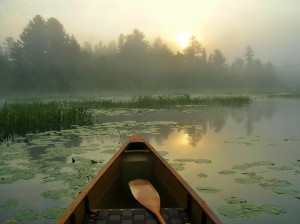 That’s a real-life shot of Joseph’s bow on Lake Traverse at sunrise…
That’s a real-life shot of Joseph’s bow on Lake Traverse at sunrise…
because Algonquin is basically heaven.
In addition to canoeing, I see that you have an educational background in both zoology and fine arts. That’s a real mix! Was one of those your first love and then the other complemented it? Or did you always know you wanted to be an artist-naturalist? I’d love to hear about that progression.
I acquired a passion for (and appreciation of) nature and wildlife at a very young age—passed on from my father. When I was 14, I bought my first 35mm camera with the express intent of becoming a wildlife photographer, which I later did for a while. But the study of wildlife remained my first passion, so I first obtained my Bachelor of Science in Zoology (Wildlife Science) from the University of Toronto and then decided to follow through with a Diploma in Photography at Humber College. Both fields would eventually be critical to the kind of art that I would do, but the art career only started years later. As for the painting part, I pretty well taught myself… first in watercolours and then in acrylics, and always by striving to improve my technique and to expand my creative vision. After a couple of years of painting wildlife (based on years of wildlife photos), I decided to focus on Algonquin Park landscapes… and the rest, as they say, is history.
I notice a favourite subject of yours is luminescence as it interacts with calm water. What speaks to you about this kind of scene?
‘Luminescence’ is pretty much the constant theme in my landscapes. Even in the first years of my career, I recognized that my misty sunrise themes yielded the most inspirational compositions, and the most dramatic responses from the public. Typically, pointing my camera towards the sunrise or sunset results in a dramatic image from which to paint. It’s also pretty obvious that most Canadians are attracted to water—even those few who don’t get to spend much time on a lake or a river. Personally, most of my best wilderness experiences have happened in a canoe at sunrise, and usually included the call of a loon or a wood thrush or an olive-sided flycatcher, or the distinctive sounds of a moose feeding at the water’s edge… or sometimes all of the above. So it stands to reason that I have always endeavoured to be “on the lake” at sunrise—not always an easy thing to do. And I consequently get to see (and photograph) a lot of scenes with dramatic lighting. My constant challenge then, in the studio, is to come out with an equally dramatic painting… a challenge that inspires me.
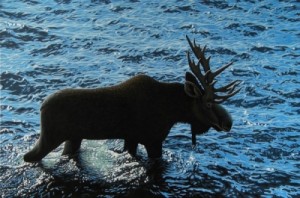 “Young Bull on the Move”
“Young Bull on the Move”
When I look at your use of light, I’m sometimes reminded of the photorealist community, but there’s an otherworldly quality to your work. Who would you say are your major artistic influences? How would You describe your work?
You know, because I came to my art career very gradually (very organically) and because I did not study art in school, I really didn’t have any major artistic influences. My years of serious photography, before starting to paint from my own photos, really formed the basis of my artistic vision—how I see landscapes. But I can say (again because of my father’s influence) that I grew up with an appreciation for most of the great Canadian wildlife artists—Robert Bateman, Glenn Loates, Michael Dumas, Fenwick Lansdowne. And I have always admired the work of two landscape artists from the past: Clarence Gagnon (Canadian) and Maxfield Parrish (American), who both featured light and colour in their art, although in very different ways. Over the years, some of my own collectors have pointed out that there is a strong similarity between my art and the “Luminism” movement of some American artists of the late 1800’s. That similarity is entirely accidental, although it’s one that I appreciate. Consequently, I sometimes refer to my own style as “Neo-Luminism”… focusing on light, depth and atmosphere. Maybe most importantly, I do paintings that take me back to that original moment on the lake… my own moment.
What are your upcoming plans? Any new themes or images you want to explore? How about new adventures on the water?
At this stage of my career (or of my life), I keep returning to the park to search for that next important composition that might help to eventually define my “oeuvre,” my body of work. In other words, I want to continue to challenge myself and to continue my paddling and camping in the hope of being on the lake for that next inspirational shot, the next engaging composition from which to work. And just like so many thousands of other backcountry paddlers, I am in no way tired of getting to Algonquin Park. “The more you go, the more you want to go back.”
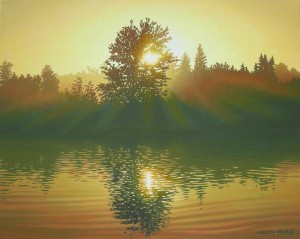 “Silver Maple-Golden Study,” a small study on its way to becoming a full-size canvas painting
“Silver Maple-Golden Study,” a small study on its way to becoming a full-size canvas painting
And last but not least… just for fun, what’s something we might not know about you?
Well, I find this to be more strange than funny. As if I haven’t already dropped enough artists’ names, Vincent van Gogh has been a magical thread running through my life, since my teens… long before I ever picked up a brush. Don McLean’s “Vincent” has always been my favourite song… it still chokes me up! My 1970’s university dorm room was plastered with Van Gogh posters, to the wonderment of some of my pals. When I first told a friend about starting to paint in 1985, he spontaneously went out and bought Lust For Life by Irving Stone for me to read… which I did twice. It’s a biography of van Gogh written in the style of a novel. Years later, during a challenging encounter with an art agent in Edmonton, a huge sculpture of van Gogh’s portrait by Joe Fafard magically appeared on a Jasper Avenue sidewalk.
It seemed to be looking right at me, helping to bring a smile to my face and calm my mood. And several other events have maintained that thread in recent years. Too funny… too strange… but true.
That’s it for now! I hope you liked getting to know Joseph a little bit, and stay posted for our next Off-Season Artists!

